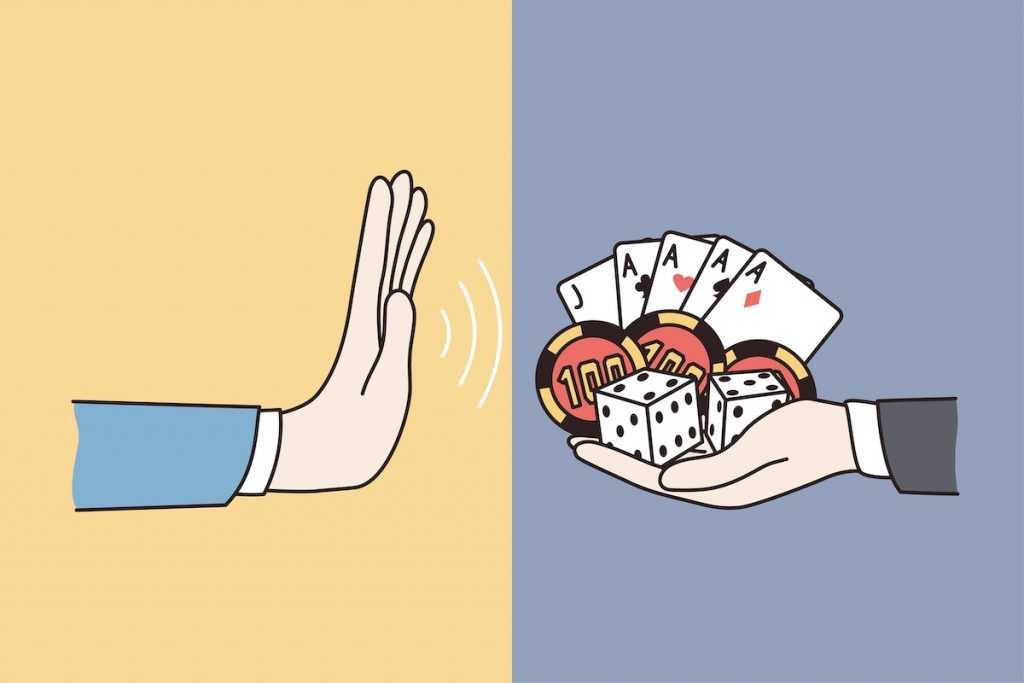Playing is a pastime that almost half of the UK inhabitants do, starting from often buying scratch playing cards to often betting on sports activities occasions. Folks have a tendency to interact in sure sorts of playing (e.g., every day scratch card purchases) extra often than others (e.g., taking part in slot machines or blackjack on the on line casino weekly); nonetheless, for most people, these types of betting are innocent and enjoyable. Many can take pleasure in inserting a wager, even when it ends in monetary loss. This doesn’t imply they’ve a playing dysfunction, simply as somebody who’s often tipsy or hungover after a celebration doesn’t essentially have an alcohol use dysfunction. Nevertheless, between 0.4% and a pair of.8% of the UK inhabitants (Public Well being England, 2019) could develop a major playing dysfunction, resulting in severe issues with their well being, funds, or different sorts of social issues.
The defining function of a playing dysfunction is its persistence, together with the widespread harms and dangers related to inserting bets. Deceit—each in direction of others and oneself—can also be a key attribute of a playing dysfunction. The urge to gamble is so intense that people will go to nice lengths to put the following wager, usually involving mendacity to hide their whereabouts, actions, and funds. They underestimate losses and overestimate positive aspects, usually participating in magical pondering: “My horse got here second; subsequent time, it should win’.
Playing and suicide are carefully linked, notably amongst males (Livingstone & Rintoul, 2021). Drawback playing considerably will increase the danger of suicidal ideas, makes an attempt, and fatalities, with downside gamblers being three to 4 occasions extra prone to try suicide, (Karlsson & Håkansson, 2018) particularly when their habit ends in monetary misery, relationship breakdowns or co-occurring psychological well being circumstances comparable to melancholy and nervousness. Monetary difficulties usually play a central position, as downside gamblers often discover themselves dealing with overwhelming money owed that result in emotions of hopelessness.
Moreover, psychological well being points, together with melancholy and nervousness, amplify the danger, as does the social isolation that many gamblers expertise resulting from stigma or strained relationships. Analysis reveals that amongst treatment-seeking sufferers with playing dysfunction, a majority suffered from a concurrent psychiatric dysfunction, together with depressive dysfunction, nervousness and co-morbid drug or alcohol habit (Sanju & Gerada, 2011). Gamblers report increased charges of feelings comparable to guilt, disgrace, lack of shallowness, loneliness, sleep issues and poor self-care.
Playing dysfunction poses a public well being difficulty. Tackling this matter necessitates early intervention and built-in therapy for habit.
Regardless of the harms attributable to playing, just one in 5 people search assist, the rest struggling in silence (Bijker et al., 2022). Really useful remedies embody cognitive behavioural remedy, self-help methods, participation in assist teams, and addressing co-occurring points comparable to housing, monetary difficulties, well being considerations, and sensible options comparable to playing blocking apps on cell phones. Nevertheless, in contrast to different areas of psychological well being, there’s a lack of strong proof to determine the simplest therapy choices, notably analysis performed within the UK.

Worsening social, well being, and particularly monetary elements can result in elevated threat of psychological well being points and suicide ideation in downside gamblers.
Strategies
A current paper (Seel et al., 2024) undertook a scientific evaluation to establish which research have been performed for people looking for therapy within the UK. The authors examined the settings, analysis designs, consequence measures used to evaluate playing remedies, and gaps within the analysis. The authors used a sturdy methodology, together with looking key databases and publications involving analysis into playing therapy performed within the UK.
Research have been included in the event that they evaluated the effectiveness of an intervention or therapy designed to enhance signs of dangerous or problematic playing, reported outcomes of interventions on therapy adherence, playing signs, or behaviours utilizing standardised measures, have been performed within the UK, and have been revealed since 2000 and ending 2023 (Seel et al., 2024).
Outcomes
Their findings are very worrying.
Solely eight research within the reviewed literature met the authors’ inclusion standards. These research primarily employed retrospective critiques, case reviews, or cross-sectional designs, and none utilised rigorous experimental methodologies comparable to randomised managed trials (RCTs). The end result follow-up durations for the research ranged from 18 months to 3 years, aside from one research inspecting the predictors of therapy dropout, which offered scientific information over 16 years. All however one of many research have been revealed throughout the final decade, and none have been revealed after the COVID-19 pandemic.
4 research employed essentially the most often used retrospective chart overview design. Moreover, one research utilised a retrospective case sequence, two targeted on single-participant case reviews, and one used a cross-sectional survey design. Case reviews have been then used to tell coverage recommendation moderately than encourage extra rigorous analysis (Jones & George, 2011). No experimental analysis designs have been recognized within the overview.
Playing therapy clinics have been essentially the most often reported settings, showing in 5 research. The opposite three research came about in areas comparable to Gamblers Nameless (GA) conferences, residential care amenities, or unspecified websites.
Cognitive-behavioural remedy (CBT) is essentially the most extensively studied intervention for playing hurt. Whereas CBT has proven promise in tackling gambling-related points, the overview highlighted the numerous lack of analysis into various approaches, together with pharmacological remedies, self-guided web interventions, and broader psychosocial interventions.
The overview discovered no proof that interventions for dangerous playing adopted recognised best-practice experimental designs, comparable to randomised managed trials. As an alternative, they overrelied on retrospective critiques of outcomes, normal information, or subjective case reviews.
Moreover, even the definition of playing dysfunction was inconsistent. Most researchers inferred severity utilizing the Drawback Playing Severity Index (PGSI) scoring standards or from self-reports. Nevertheless, the PGSI doesn’t present a proper analysis of playing dysfunction, and its accuracy and validity in figuring out points can fluctuate. Self-reporting is usually additionally inconsistent and, as with the PGSI, doesn’t supply a proper analysis of playing dysfunction appropriate for analysis functions. Seel et al. advocate utilising extra sturdy standards, such because the DSM-5 or ICD-11. Solely one of many research employed the most recent DSM-based diagnostic instrument.
Research not often supplied particulars about recruitment standards and sometimes consisted solely of secondary evaluation of inside scientific audits. Just one research famous conflicts of curiosity, and funding info was offered in solely two.

The overview discovered no playing intervention research utilizing randomised managed trials, elevating considerations in regards to the lack of rigorous, evidence-based therapy analysis on this area.
Conclusions
This overview highlights the pressing want for complete analysis to construct a robust proof base for efficient playing hurt interventions within the UK.
With out analysis, clinicians are working at the hours of darkness, extrapolating from the therapy of different non-behavioural addictions or from worldwide analysis, which could not be instantly relevant to a UK cohort of sufferers. By adopting a extra methodologically rigorous method, the sphere can extra successfully handle gambling-related harms’ complicated and far-reaching impacts.
The authors say there may be:
an pressing want to determine new analysis priorities to assist the therapy of dangerous playing.

With out sturdy UK-based analysis, clinicians are left navigating playing hurt therapy at the hours of darkness, counting on restricted or non-applicable worldwide information.
Strengths and limitations
There are a number of limitations which the authors acknowledge of their overview. For instance, they didn’t conduct a threat of bias evaluation, as this isn’t usually a part of normal observe for scoping critiques aimed toward mapping proof. Nevertheless, such an evaluation might need been useful in evaluating the robustness of every included research by way of their methodological and reporting high quality. Moreover, the small variety of included research restricted the opportunity of a extra detailed examination of potential biases.
Furthermore, the overview targeted completely on UK-based therapy literature, as the first goal was to discover this space for the primary time, notably in creating the NICE pointers for dangerous playing therapy. Consequently, it excluded research from nations with completely different coverage and legislative frameworks on playing therapy.
Future analysis would profit from inspecting the worldwide literature to establish widespread approaches, sensible methods, and potential gaps in treating dangerous playing throughout varied settings. Increasing the scope to incorporate worldwide research might supply a broader perspective and improve the generalisability of findings, in the end resulting in the event of extra complete therapy frameworks.
Nevertheless, the restrictions come up not primarily from the paper itself, a radical evaluation and well-conducted scoping overview, however moderately from the content material of what they have been exploring: the dearth of high quality research originating from the UK. The authors recommend that this may occasionally stem from points associated to funding for analysis, which has come primarily from voluntary levies imposed by the playing trade and fines levied by the Playing Fee on playing suppliers. This funding supply might have discouraged researchers from making use of for funds resulting from considerations about being perceived as below the affect of the trade or potential conflicts of curiosity.

The imposition of the playing trade could have impaired the expansion of analysis on playing.
Implications for observe
The authors advocate a complete overhaul of the UK analysis method to playing hurt interventions. This consists of extra vital funding in experimental analysis, creating standardised therapy protocols, and broader recruitment methods to make sure consultant samples. Additionally they emphasise the significance of addressing systemic limitations, comparable to restricted funding and inadequate collaboration amongst researchers, clinicians, and policymakers. The excellent news is that the UK authorities’s introduction of a statutory levy on playing operators is poised to boost analysis into gambling-related harms considerably. Aiming to start out in April 2025, this levy is anticipated to generate roughly £100 million yearly, with 20%—round £20 million—explicitly allotted for analysis functions. With this levy in place, analysis efforts will be extra strategically deliberate and executed, fostering a deeper understanding of playing behaviours, the effectiveness of interventions, and the event of evidence-based insurance policies.
A greater proof base for treating people affected by gambling-related harms ensures that interventions are efficient and account for a range of wants, together with completely different affected person populations. That is particularly evident because of the social, psychological, and monetary results that households, communities, the broader society, and the person can subsequently expertise. For instance, an necessary space for analysis is whether or not completely different therapy approaches may want to contemplate gender. As a result of stigma and stereotypes primarily associating playing with males, it’s potential that gambling-related harms in ladies could go unrecognised. Girls could not search playing therapy resulting from many causes, together with stigma, disgrace, worry of judgment, childcare duties, co-occurring psychological well being points, or mistrust in therapy. Addressing these requires women-centric, trauma-informed, accessible companies, decreasing stigma, and providing versatile, inexpensive, and supportive interventions (Hing et al., 2016). Efficient options require ongoing analysis.
Moreover, prisoners symbolize a high-risk group for downside playing, with engagement usually exacerbating substance misuse, psychological well being points, and recidivism. Proof-based interventions inside correctional settings can handle underlying causes, serving to to interrupt the cycle of hurt and thus enhance the chance of rehabilitation.
There are various distinctive challenges confronted by minority teams that add complexity to creating these evidence-based remedies, comparable to cultural stigmas, discrimination, and limitations to accessing needed therapy. These complexities are essential to contemplate offering culturally delicate and inclusive care.
With out robust proof to assist the event of those remedies, the danger of ineffective care is heightened, resulting in an elevated chance of hurt and the perpetuation of inequalities. Due to this fact, using this rigorous analysis can make sure that related interventions deal with the foundation causes of gambling-related harms whereas decreasing stigma and remaining person-centred. Creating these methods is important for bettering therapy outcomes for people and addressing well being disparities between demographics, which might foster more healthy communities. That is actually an space the place “extra analysis is required”.

A greater proof base for treating people affected by gambling-related harms ensures that interventions are efficient and account for a range of wants, together with completely different affected person populations.
Assertion of pursuits
Each RW and CG are funded to ship care by way of the Major Care Playing Service by a grant from Gamble Conscious.
Hyperlinks
Major paper
Seel, C. J., Jones, M., Christensen, D. R., Might, R., Hoon, A. E., & Dymond, S. (2024). Therapy of dangerous playing: A scoping overview of United Kingdom-based intervention analysis. BMC Psychiatry, 24(1), 392.
Different references
Bijker, R., Sales space, N., Merkouris, S. S., Dowling, N. A., & Rodda, S. N. (2022). World prevalence of help-seeking for downside playing: A scientific overview and meta-analysis. Habit (Abingdon, England), 117(12), 2972–2985.
Hing, N., Russell, A., Tolchard, B., & Nower, L. (2016). Danger Components for Playing Issues: An Evaluation by Gender. Journal of Playing Research, 32(2), 511–534.
Jones, H. B., & George, S. (2011). ‘You by no means advised me I’d flip right into a gambler’: A primary individual account of dopamine agonist – induced playing habit in a affected person with stressed legs syndrome. BMJ Case Reviews, 2011, bcr0720114459.
Karlsson, A., & Håkansson, A. (2018). Playing dysfunction, elevated mortality, suicidality, and related comorbidity: A longitudinal nationwide register research. Journal of Behavioral Addictions, 7(4), 1091–1099.
Livingstone, C., & Rintoul, A. (2021). Playing-related suicidality: Stigma, disgrace, and neglect. The Lancet Public Well being, 6(1), e4–e5.
Might-Chahal, C., Humphreys, L., Clifton, A., Francis, B., & Reith, G. (2017). Playing Hurt and Crime Careers. Journal of Playing Research, 33(1), 65–84.
Public Well being England. (2019). Playing Associated Harms Proof Overview.
Sanju, G., & Gerada, C. (2011). Drawback gamblers in major care: Can GPs do extra? The British Journal of Common Follow,61(585), 248–249.
Picture credit
Source link



